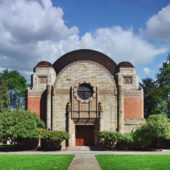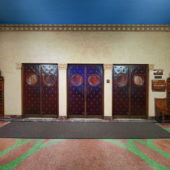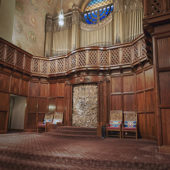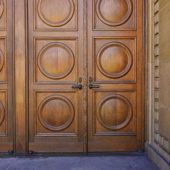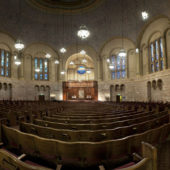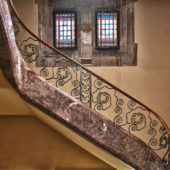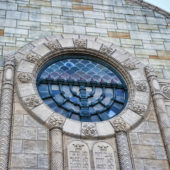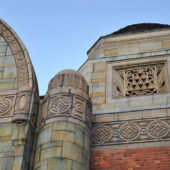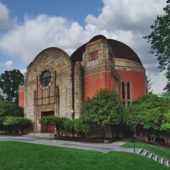At the synagogue’s dedication the Rabbi said “There is no Synagogue of my experience that is as exquisite as ths one …. in all respects it is like a lyric poem in brick and stone ….”
The California Gold Rush caused much of the Jewish immigration from the East Coast, Midwest and California to Oregon, as resourceful Jewish merchants moved north of California to obtain supplies to trade with the farmers who provisioned the West’s mining towns. Jacob Goldsmith and Lewis May were the first Jews to settle in Portland, Oregon in 1849. They were from Bavaria and operated a general merchandise store on Front Avenue. Three years later, Mrs. Weinshank was the first Jewish woman in Oregon, to open a boarding house for bachelors in Portland. In 1858 Congregation Beth Israel was founded as not only Portland’s first synagogue, but the state’s first synagogue. In 1896 the Ladies’ Hebrew Benevolent Society founded the Portland Chapter of the National Council of Jewish Women. Its purpose was to provide education and assistace to South Portland’s immigrants. Eastern European Jews also settled in South Portland after the turn of the century. Within another twenty years, the Jewish population in the area had mushroomed to over 6,000 people. The Jewish Shelter Home was founded in 1920, to care for children who were separated from their parents either by illness death or poverty. In 1947 the Jewish Shelter Home merged with the Jewish Service Association to form the present-day Portland Jewish Family and Child Service.
Since Beth Israel’s inception in 1858, before statehood when Oregon was still part of the Oregon Territory, it has been the center for Reform Judaism in the Pacific Northwest. It was the first synagogue west of the Rockies and north of California and originally held its services in Burke’s Hall, above a livery stable. The congregation built its first synagogue in 1859, an A-framed structure. Over the next thirty years the congregation grew substantially and required a larger building. They built a new synagogue, which was completed in 1889, which was rather grand, with twin towers flanking either side of the entrance. Sadly, this synagogue was destroyed by fire in 1923. Plans for a new temple were drawn and the current Byzantine masterpiece was completed in 1928.
The building is considered one of the best examples of Byzantine architecture in the Northwest and was added to the National Register of Historic Places. Underneath its large dome, the façade of red brick is offset by gray stone and molding. Both inside and out the building exudes an aura of careful design, planning and construction. The synagogue’s beauty and high quality detail are awe inspiring. A large round stained-glass window sits above the main entrance, with another at the opposite end of the building, and groups of two and three tall, slim arched stained-glass windows grace the side walls. Inside the magnificent prayer room, the eye is drawn toward the Aron Kodesh, set into a splendid wood-paneled alcove. The Aron Kodesh is vertically rectangular and intricately carved, all in gold. Above the wood paneling within the alcove is a large, menorah motif, round stained-glass window in blues and golds, surrounded by gold organ pipes on either side and below. Hand-painted Byzantine motifs are painted onto the wall above the window and organ pipes. On the platform to the left is the tivah (reader’s desk), simply carved in wood. Numerous specially designed and built chandeliers drop from the ceiling to light the room. The sanctuary is filled with comfortably upholstered, stationary wood chairs sitting on patterned carpeting.
The congregation continued to grow after this synagogue was completed, so opposite the Temple, the Sherman Education Center was built in 1948 and expanded in 1994. The Center houses an auditorium, chapel, preschool, classrooms, offices, and gift shop, etc. In 1957 Harris Hall was acquired to expand the religious school. In 1993 the Family Center was dedicated, which houses a chapel, foyer, hall, boardroom and administrative offices. The congregation also owns Landau Chapel Cemetery, in nearby Southwest Portland.
Today, over 800 families from all backgrounds experience a dynamic and meaningful Jewish experience at Beth Israel. Services are held in the historic sanctuary and in the newer chapel-sanctuary in the Family Center. The focus of the ministry is fourfold: improving the world through education, leadership and inspiration; promoting traditional Jewish values of respect, justice and compassion; providing and inspirational environment of worship, spirituality and celebration across the generations; and deepening the congregants connection to God and Judaism.

